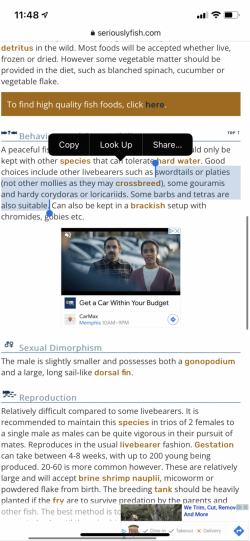Do you think there are tetras and such that come from the same waters as the Mollies? With the same GH/PH
Again being general--no, there are no common tetras in the same waters. I am going from memory here, but I cannot recall any. Not that I know every species of characin and its location, but they do not inhabit the same habitats.
Here's a bit of history.
The ancestor of all modern Characiformes appeared when the two southern continents of Africa and South America were part of the supercontinent called Gondwana [Lundberg 1993; Ortí and Meyer 1997]. The breakup of the two continents allowed the characins in what became South America to take full advantage of the potential [=empty or not fully-exploited] ecological niches, and the characids underwent explosive radiation unlike any other in all the vertebrates except for the marsupials in Australia. There was no opportunity for these fishes to move into the separate Central/North American continent, since there was (and still is) no connecting freshwater courses.
What follows will contradict my previous comments, I did say I was being very general, but now we are getting into more substantive issues.
The Family Poeciliidae is known as livebearers, and aquarists tend to think of them as occurring chiefly in Mexico and Central America, but they actually extend from SE United States down into northern Argentina. The majority of species are either true live-bearing species [viviparous] or have internal fertilization with the eggs hatching before being laid so that the female produces live young [ovoviviparous]. Except for one genus, all the American species are live bearing. But there are also some egg scattering species with external fertilization, and these all occur in Africa. The distribution of the Subfamily in Africa and America suggests that the Poeciliidae pre-date the separation of Africa and South America that occurred during the early Cretaceous period some 130 million years ago. Live bearing subsequently evolved in the American species.
I have personally never come across any of the South American livebearing species, except for
Poecilia (Acanthophacelus) wingei, common name Endler's Livebearer, which occurs in northeast Venezuela, endemic to Campoma and Buena Vista coastal lagoons. The source for the type specimens is a warm freshwater lake with hard, alkaline water on the Paria Peninsula. The species is feared to be extinct in the habitat lake in which it was discovered due to pollution from garbage. The common name "Endler's Guppy" honours John Endler who "discovered" the species in 1975, although it was actually first discovered in 1937 by Franklin Bond. A second possible site was mentioned by Dr. Endler but he was unable to find it. Schories et al. (2009) document this species occurring in the Cumana region.
It was not until 2005 that the species was scientifically described as a distinct species by F.N. Poeser, M. Kempkes & I.J.H. Isbrucker. Poeser et al. (2005) proposed re-establishing the genus name
Acanthophacelus, originally erected by Eigenmann in 1907 and subsequently deemed a synonym for
Poecilia, as a sub-genus of
Poecilia. Schories et al. (2009) have followed this provisional sub-classification for the (now) three guppy species on the basis of generic differences from the other species in the subfamily.
@emeraldking is much more up on this family than I am, and he may be able to mention other SA species. They are certainly not the standard fish we see in the hobby, so far as I know anyway.


